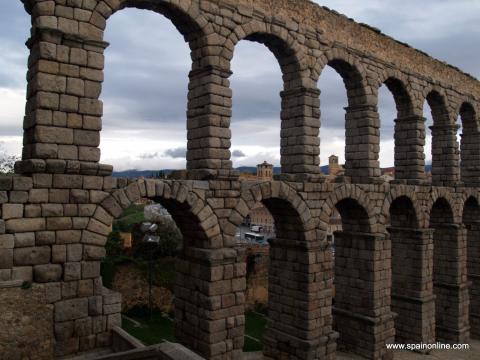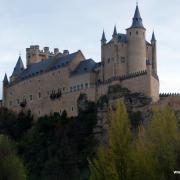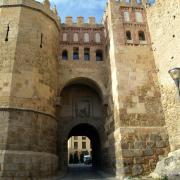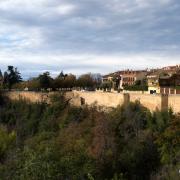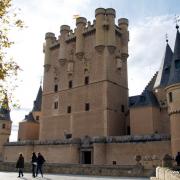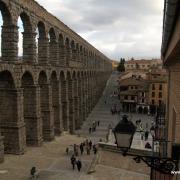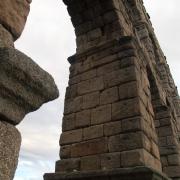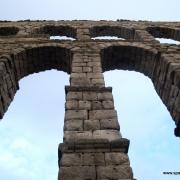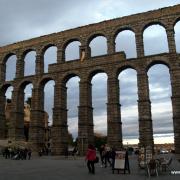Location in Spain:
Category:
Hoteles y apartamentos en Segovia
Segovia is best known for it's well preserved roman Aqueduct, that is still operative. In 1985, it was declared declared a World Heritage Site by UNESCO together with the historic disctrict of Segovia. Many of the buildings in the city have also been declared Artistic Historical Monuments. Segovia forms part of the main route of the Camino de Santiago de Madrid (an important pilgrimage also known as 'The Way of St James').
Santiago de Madrid (an important pilgrimage also known as 'The Way of St James').
The capital city of the Segovia Province in the autonomous community of Castile and Leon is situated to the north of Madrid (35 minutes away by high speed train). The province of Segovia is neighboured by Burgos and Valladolid to the north, Avila to the west, Soria to the east and Madrid and Guadalajara to the south.
Places to visit
Some of the most important monuments in the city include:
- The Aqueduct of Segovia
Located in the Plaza del Azoguejo, is one of the most impressive works of civil engineering built by the Romans. Its purpose was to carry water from the mountains to Segovia. Over time it has become the symbol of the city and legend has it that it was built by the devil. - The Segovia Cathedral
Located in Plaza Mayor was the last Gothic cathedral to be built in Spain. Construction on the cathedral began in 1525 under the direction of the Gil de Hontañón family of architects. It was built to replace the Old Cathedral that was destroyed during the Revolt of the Comuneros in 1520. The tower on the Epistle side of the Cathedral, is one of its most striking features. The Cathedral contains 18 chapels and a cloister designed by Juan Guas, which was taken from the old Romanesque cathedral and transported stone by stone. It currently leads to the Cathedral's museum. - The Alcazar of Segovia
Located on top of a rock between the Eresma and Clamores rivers. It became the royal palace in the 13th Century and was one of the favourite residences of the Kings of Castile. Its architecture is a combination of Romanesque, gothic and mudejar styles. It was devastated by a fire in 1862 but was later restored during the reign of Alfonso XII. Since then, the Alcázar Trust has continued this work, restoring its coffered ceilings, friezes, altarpieces and walls. It currently houses the Royal School of Artillery Museum and the General Militar de Segovia archive. - The City Walls
which are made of limestone and granite and surround the city with a perimeter more than 3,000 meters (starting and ending at the Alcazar). Tombstones from the old Roman necropolis were also used in its construction. The walls also originally had five gates called Santiago, San Cebrián, San Juan, San Martín and San Andrés, of which only three remain (San Cebrián, Santiago and San Andrés). There are also a number of surviving wicket gates.
Gastronomy
Typical local cuisine includes a wide range of meat such as "lechazo" (tender young lamb) and "cochinillo" (slow roasted suckling-pig). The highland rivers also provide the province with "trucha" (trout).The local nuns also make a wide variety of traditional pastries and desserts including "ponche segoviano" which is lightly toasted on the outside with a creamy filling. There are also a wide variety of locally produced wines, such as the white wine from Nieva and Valtiendas' red wines.
Festivals and National Holidays
The main festivals and celebrations in Segovia include:
- Holy Week (or Easter)
when there are a number of religious processions with floats and statues. The processions on Palm Sunday and Good Friday are particular highlights. - Titirimundi
which takes place in May, and is a huge festival with street performers and puppet theatre. - The fairs and fiestas of San Juan and San Pedro
These festivities have been held in the city since the 15th century and currently take place between the 23rd to 29th June when the city is filled with fairground rides, concerts, theatre, bullfighting and sporting activities. - The procession of la Virgen de la Fuencisla
Every year, nine days before the Day of the Virgen de la Fuencisla, the statue of the Virgin is taken to the Cathedral where it is venerated for nine days. The statue of the Virgin is then taken back to her sanctuary in a procession accompanied by traditional music and dancing. - The San Frutos Festival
This festival takes places on 25th October when many Segovians gather in the Cathedral to sing the traditional 'San Frutos Carol'. After this, a number of activities take place in the Plaza Mayor.The night before, many Segovians also go to the Cathedral door, where there is a statue of San Frutos holding a book. They go to see San Frutos turn the page of the book and to sample the Sopas del Santo (a special soup prepared by the Association of the Chefs of Segovia).
A brief history of Segovia
Segovia, which was originally founded by the Celts, later became an important Roman settlement before its domination by the Visigoths (from the 6th century) and Moors. It eventually fell to the Christians in the 11th Century. The Romans left a magnificent legacy in the form of the Aqueduct which is the tallest in Spain and one of the best-preserved in the world. The huge scale of this feat of engineering suggests that 2,000 years ago Segovia must have had roughly the same amount of inhabitants as it has today.
In recent history, after the Spanish Civil War (1936-39) a commercial and business zone began to develop and tourism flourished as Segovia established a reputation as one of the most beautiful and historic cities in Spain.
Todos los hoteles de Segovia - en una lista | en el mapa >>>

